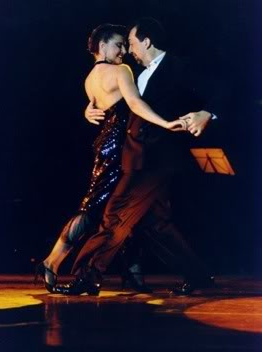In the world-wide community of Argentine tango, there are a few maestros that are sought after everywhere. These are people who have studied, danced, and written about tango so extensively that to study with them means that you'll receive the distilled essence of the form itself.
One of these maestros is Gustavo Naveira.
With his wife Giselle Anne, Gustavo displays a complete knowledge of tango movement and the reasons why tango works so marvelously as a dance form. To study with them is to receive an encyclopedic -- and very exciting -- knowledge of where tango comes from, of its traditions and grand forms, its lore, its music and extraordinary musicality. You don't just do steps, as is so often the case in dance classes, even those taught by other considerable Argentine maestros. Gustavo displays the variations. He asks, "Why do it this way instead of that way?" He changes direction in ways that at first appear impossible, but, done the way they do it, seem altogether natural.
 Photo: www.gustavoygiselle.com Used with permission.
Photo: www.gustavoygiselle.com Used with permission.
The noted Argentine maestra Nora Olivera suggested that my partner Beatrice Bowles and I study with Gustavo. She counseled us that, although this would be one of the most difficult things we would ever do in tango, it would reward us many-fold. New understandings. A more profound way of approaching the music. A view of tango dance movement that would be far more broad and meaningful than anything we had ever seen before.
A class from Gustavo and Giselle Anne begins simply enough. He is not a tall man, in his forties with very dark hair, who dresses for the classes simply in a pair of slacks, a sport shirt and shoes. Seeing him walk across the street, you would not suspect that you were watching a volcanic arbiter of great dance and a noted historian of the genre.
Gustavo has been teaching worldwide for many years. Asked in a 2004 interview in the Argentine publication Pagina 12 why so many people outside of Argentina wanted to study tango, he said "It's a dance that offers you a number of answers to the problems of modern life ... and it's a guide to communication that goes far beyond language and culture."
A 1999 article in El Clarín, one of the two major Buenos Aires dailies, laid out Gustavo's importance to the development of contemporary tango. Talking about the innovative styles of dance that were coming at the time from the Buenos Aires neighborhood Villa Urquiza and from the Club Almagro, the article stated, "You could say that three stylistic tendencies contend for supremacy (in Buenos Aires), Urquiza's style, Almagro's style and Naveira's style."
Gustavo begins a class with something like, "Well, today we are going to think about ganchos," the widely-known move in which one partner's leg encounters that of the other partner in a kind of hooking motion. It's an invasion by one partner of the other person's space that, when done properly, provides an electrifying moment of conflict, engagement, and resolution.
"Now what do you suppose a gancho really is?" he will ask, and therein begins a long, thoughtful, and conscientious discussion of a move in tango that defines the very form itself.
He and Giselle Anne will demonstrate the various concepts of the gancho upon which they've based their ideas, and the demonstrations become more and more complicated as the session moves along. What is heart-stopping is the beauty of what they have to show and the organization of thought that Gustavo brings to his teaching.
They have ruminated deeply about these moves and interactions, and this is especially clear in the interplay between showing the thing to their students, helping the students do it, and then talking about it. The dance sequence takes just a moment. But the practicing and the instruction may take all day. The overall effect is one of careful consideration of the traditions of tango, and the way in which these traditions fuel new creativity.
With another young maestro named Fabian Salas, Gustavo is credited with having introduced the concept of "nuevo tango" to the world, "new tango." It features a very inventive manner of doing tango, in which dancers will move from a steady axis of balance to a quite off-balance mode that requires different thinking than that in so-called traditional tango. But when he speaks of this, Gustavo talks about how he learned of all these "revolutionary" moves by watching old-style tangueros in the milongas (dance-hall parties) and boliches (little neighborhood clubs) of Buenos Aires.
In a 2001 interview, Fabian Salas asked "What did we invent? Nothing... Everything was already there. Even what in the beginning we called 'alterations' and then, later, 'changes in direction'. But we didn't invent them. They were there."
What they brought to the process was a way of explaining what the tangueros had been doing for years. Of course there was significant creativity on the part of Gustavo and Fabian themselves, inventive re-workings of the movements. But their respect for the older milonguero tradition, as it's called, is obvious and very artfully demonstrated by both men.
Note: This article first appeared in the San Francisco Chronicle.
